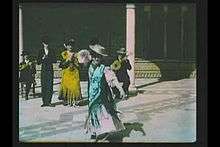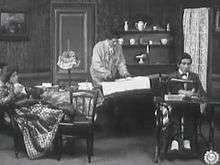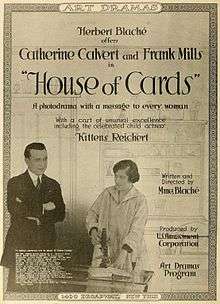Alice Guy-Blaché
| Alice Guy-Blaché | |
|---|---|
 Alice Guy at the end of the nineteenth century. | |
| Born |
Alice Ida Antoinette Guy July 1, 1873 Saint-Mandé, France |
| Died |
March 24, 1968 (aged 94) Wayne, New Jersey, U.S.[1] |
| Nationality | French |
| Occupation | Filmmaker, director, screenwriter, producer, actress |
| Years active | 1894–1922 |
| Spouse(s) | Herbert Blaché |
| Children | Simone, Reginald |
Alice Guy-Blaché (July 1, 1873 – March 24, 1968) was the first person to be a film director and writer of narrative fiction films. She experimented with Gaumont's Chronophone sound syncing system, color tinting, interracial casting, and special effects.[2]
Early life and education
In 1865,[3] Alice's father, Emile Guy, an owner of a bookstore and publishing company in Santiago and Valparaiso, Chile, married Marie Clotilde Franceline Aubert. The couple returned to Santiago, Chile after the wedding in Paris. In early 1873, Marie and Emile lived in Santiago, with Alice's siblings.
There was a devastating smallpox epidemic in Chile in 1872 and 1873.[4] Emile and Marie Guy brought all four of their children back to Paris where Alice was born. In her autobiography, Alice refers to her mother's attempt to make sure "one of her children should be French". Her father returned to Chile soon after her birth, and her mother was quick to follow. Alice was entrusted to her grandmother in Carouge, Switzerland.[5] At the age of three or four, Alice was taken to Chile by her mother.
At the age of six, Alice was taken back to France by her father to attend school at the Convent of the Sacred Heart on the Swiss border. (Her siblings were already there.) Her father died on January 5, 1891 of unknown causes.[6]
Following her father's death, Guy trained as a typist and stenographer, a new field at the time, to support herself and her widowed mother. She landed her first stenography-typist job at a varnish factory. In 1894, she began working at the 'Comptoir général de la photographie' owned by Felix-Max Richard. Léon Gaumont would later take over and head the company.[7]
Gaumont, France



In 1894, Guy was hired by Felix-Max Richard to work for a camera manufacturing and photography supply company as a secretary. The company changed hands in 1895 due to a court decision against Felix-Max Richard who sold the company to four men: Gustave Eiffel, Joseph Vallot, Alfred Besnier, and Leon Gaumont. Gustave Eiffel was president of the company, and Leon Gaumont, thirty years Eiffel's junior, was the manager. The company was named after Gaumont because Eiffel was the subject of a national scandal regarding the Panama Canal. [8] L. Gaumont et Cie became a major force in the fledgling motion-picture industry in France. Alice continued to work at Gaumont et Cie, a decision that led to a pioneering career in filmmaking that spanned more than 25 years and involved her directing, producing, writing and/or overseeing more than 700 films.[9]
Although she initially began working for Léon Gaumont as his secretary, she began to learn became familiar with myriad clients, relevant marketing strategies, and the company's stock of cameras. She also met a handful of pioneering film engineers such as Georges Demenÿ and Auguste and Louis Lumière.
Guy and Léon Gaumont attended the "surprise"[10] Lumière event on March 22, 1895. It was the first demonstration of film projection, an obstacle that Gaumont and the Lumières (as well as Edison) were racing to solve. They screened one of their early films Workers Leaving the Lumière Factory, and it only consisted of a simple scene of workmen leaving the Lumière plant in Lyon. Bored with the idea of captured film only being used for the scientific and/or promotional purpose of selling cameras in the form of "demonstration films", she was confident that she could incorporate fictional story-telling elements into film. She asked Léon Gaumont for permission to make her own film, and he granted it.
Alice Guy's first film, and arguably the world's first narrative film, was called La Fée aux Choux (The Fairy of the Cabbages) or The Birth of Infants, in 1896. The scene Alice described does not match either the 1900 or the 1902 versions that have been discovered. Alice said she filmed the first version "before May" 1896. A July 30, 1896 newspaper describes a "chaste fiction of children born under the cabbages in a wonderfully framed chromo landscape" and provides other details that confirm Alice's description of her first film. [11][12]
From 1896 to 1906, Guy was Gaumont's head of production and is generally considered to be the first filmmaker to systematically develop narrative filmmaking. She was probably the only female director from 1896 to 1906.[13] Her earlier films share many characteristics and themes with her contemporary competitors, such as the Auguste and Louis Lumière and Méliès. She explored dance and travel films, often combining the two, such as Le Bolero performed by Miss Saharet (1905) and Tango (1905). Many of Guy's early dance films were popular in music-hall attractions such as the serpentine dance films – also a staple of the Lumières and Thomas Edison film catalogs.[14]
In 1906, she made The Life of Christ, a big budget production for the time, which included 300 extras. In addition to this, she was one of the pioneers in the use of audio recordings in conjunction with the images on screen in Gaumont's "Chronophone" system, which used a vertical-cut disc synchronized to the film. She employed some of the first special effects, including using double exposure, masking techniques, and running a film backwards.
Solax

In 1907, Alice Guy married Herbert Blaché who was soon appointed the production manager for Gaumont's operations in the United States. After working with her husband for Gaumont in the U.S., the two struck out on their own in 1910, partnering with George A. Magie in the formation of The Solax Company, the largest pre-Hollywood studio in America.[9]
With production facilities for their new company in Flushing, Queens, New York City, her husband served as production manager as well as cinematographer, and Alice Guy-Blaché worked as the artistic director and directed many of its releases. Within two years, they had become so successful that they invested more than $100,000 into new and technologically advanced production facilities in Fort Lee, New Jersey. Many early film studios were based in Fort Lee at the beginning of the 20th century.[15][16][17] It was mentioned in publications of the era that Guy-Blaché placed a large sign in her studio that read: 'Be Natural'.[9]
Alice Guy and her husband divorced several years later, and with the rise of the more hospitable and cost-effective climate in Hollywood, their film partnership also ended.
Personal life

_-_2.jpg)
Guy-Blaché's marriage meant that she had to resign from her position working with Gaumont. Looking for new beginnings, the couple immigrated to New York where Guy gave birth to her first daughter Simone in 1908.[18] Two years after giving birth, Guy became the first woman to run her own studio when she created Solax. During this time, Guy was pregnant with her second child, but it did not stop her from completing at least one to three films a week. To focus on writing and directing, Guy made her husband the president of Solax in 1914.
Shortly after taking the position, Herbert Blaché started his own film company to elude the creative control of bankers. For the next few years, the couple maintained a personal and business partnership, working together on many projects. The relationship between the two did not last long. In 1918, Herbert Blaché left his wife and children to pursue a career in Hollywood with another one of his actresses.[18] Alice almost died from the Spanish flu pandemic in October 1918.[19]
Following this, Guy directed her last film in 1920. By 1922, Alice and Herbert were officially divorced, prompting her to auction her film studio while claiming bankruptcy. After losing her studio, she returned to France in 1922 and never made a film again.[18] Following her bankruptcy and divorce, she was unable to continue to make a living making films.
Death
Alice Guy-Blaché never remarried, and in 1964 she returned to the United States to stay with one of her daughters. On March 24, 1968, Guy died at the age of 94 while living at a nursing home[20] in New Jersey. She is interred at Maryrest Cemetery.[21]
Legacy and tributes
In the late 1940s, Guy-Blaché wrote an autobiography, and in 1976 it was published in French. It was translated into English in 1986 with the help of her daughter Simone and daughter-in-law Roberta Blaché and film writer Anthony Slide.
Guy-Blaché was tremendously concerned with her unexplained absence from the historical record of the film industry. She was in constant communication with colleagues and film historians correcting previously made and supposedly factual statements about her life. She crafted lengthy lists of her films as she remembered them, with the hope of being able to assume creative ownership and get legitimate credit for them.[22]
Guy-Blaché is the first female filmmaker, and from 1896 to 1920, she directed over 1,000 films, some 350 of which survive, and 22 of which are feature-length films.
Guy was one of the first women (along with Lois Weber) to manage and own her own studio: The Solax Company. Few of her films survive in an easily viewable format.
In 1953, Guy was awarded the Légion d'honneur, the highest non-military award France offers. On March 16, 1957, she was honored in a Cinématheque Française ceremony that went unnoticed by the press.[20]
In 2004, the only existing historic marker dedicated to Alice Guy-Blaché in the United States was unveiled on the location of her Solax Studio in Fort Lee, New Jersey by the Fort Lee Film Commission.
In 2010 the Academy Film Archive preserved Alice Guy-Blaché's short film The Girl in the Arm-Chair.[23]
In 2011, an off Broadway production of Flight[24] premiered at the Connelly Theatre, featuring a fictionalized portrayal of Alice Guy-Blaché as a 1913 documentary filmmaker. Also in 2011, the Fort Lee Film Commission successfully lobbied the Directors Guild of America to accept Alice Guy-Blaché as a member.[25]
In 2012, for the centennial of the founding and building of Guy-Blaché's Solax Studio in Fort Lee, the Fort Lee Film Commission raised funds to replace her grave marker in Maryrest Cemetery in Mahwah, New Jersey. The new marker includes the Solax studio logo and indicates her role as a cinema pioneer.
She was the subject of a National Film Board of Canada documentary The Lost Garden: The Life and Cinema of Alice Guy-Blaché by director Marquise Lepage, which received Quebec's Gemeaux Award for Best Documentary.[26] In 2002, film scholar Alison McMahan published Alice Guy Blaché: Lost Visionary of the Cinema.
In 2013, Guy-Blaché was inducted into the New Jersey Hall of Fame.[27]
In 2014, film podcast "Hell Is for Hyphenates" devoted a segment to exploring the career of Alice Guy-Blaché.
Selected filmography
- La Fée aux Choux (The Fairy of the Cabbages'; 1896)
- Le chiffonnier (1898)
- Danse serpentine (1900)
- Bataille de boules de neige (1900)
- Les Résultats du féminisme (1906)
- Fanfan la Tulipe (1907)
- One Touch of Nature (1908)
- The Sergeant's Daughter (1910)
- The Pawnshop (1910)
- Greater Love Hath No Man (1911)
- La Esméralda (1905) (based on the Victor Hugo novel, The Hunchback of Notre Dame)
- Algie the Miner (1912)
- Falling Leaves (1912)
- Making an American Citizen (1912)
- The Pit and the Pendulum (1913)
- Matrimony's Speed Limit (1913)
- The Lure (1914)
- The Shooting of Dan McGrew (1915)
- The Great Adventure (1918)
- Tarnished Reputations (1920)
See also
References
- ↑ As reported in the margins of p. 91 of birth certificate Archived 2014-03-31 at the Wayback Machine. from the city of Saint-Mandé.
- ↑ "Alice Guy-Blaché". Biography.com. A&E Television Networks. Retrieved May 3, 2015.
- ↑ Archives de Paris, Marriages, 18 Juilliet 1865, Clichy Hauts de Seine, 4 E/CLI_66.
- ↑ New York Times, South America, Terrible Ravages of Small-Pox on the West Coast, September 26, 1872.
- ↑ Nicolas Aubert, her grandfather, died October 11, 1872
- ↑ Archives de Paris, Deces 6e arr. 5 Janvier 1891 V4E5962
- ↑ Alice Guy Blaché: Cinema Pioneer. ISBN 978-0-300-15250-0.
- ↑ Les premieres annees de la societe L. Gaumont et Cie, Correspondance commercialed de Leon Gaumont 1895-1899. Corcy, Malthete, Mannoni, Laurent, Meusy, 1998
- 1 2 3 "The Lost Garden: The Life and Cinema of Alice Guy-Blaché". Nfb.ca. 2012-05-02. Retrieved 2012-06-24.
- ↑ Bachy, Victor. Entretiens avec Alice Guy. p. 41.
- ↑ Gil Blas, 30 July 1896
- ↑ Dietrick, Janelle, Alice & Eiffel, A New History of Early Cinema and the Love Story Kept Secret for a Century,pp. 193-203, 2016
- ↑ "Alice Guy Blaché – Women Film Pioneers Project". wfpp.cdrs.columbia.edu. Retrieved 2016-03-31.
- ↑ Simon, Joan. Alice Guy Blaché Cinema Pioneer. ISBN 978-0-300-15250-0.
- ↑ Koszarski, Richard (2004), Fort Lee: The Film Town, Rome, Italy: John Libbey Publishing, ISBN 0-86196-653-8
- ↑ "Fort Lee Film Commission". Fort Lee Film Commission. Retrieved December 19, 2016.
- ↑ Fort Lee Film Commission (2006), Fort Lee Birthplace of the Motion Picture Industry, Arcadia Publishing, ISBN 0-7385-4501-5
- 1 2 3 "Alice Guy-Blaché profile". Aliceguyblance.com. Retrieved November 11, 2014.
- ↑ Mme Blache Ill, The Film Daily, October 27, 1918, p. 7
- 1 2 McMahan, Alison J. (1997). Madame a des envies (Madam has her cravings): A critical analysis of the short films of Alice Guy Blaché, the first woman filmmaker. Ph.D. dissertation, The Union Institute, United States—Ohio, from Dissertations & Theses: A&I (publication No. AAT 9817949).
- ↑ "Find-a-Grave". Findagrave.com. Retrieved November 11, 2014.
- ↑ Simon, Joan. The Great Adventure: Alice Guy Blaché, Cinema Pioneer. Whitney Museum of American Art. pp. 1–5. ISBN 978-0-300-15250-0.
- ↑ "Preserved Projects". Academy Film Archive. Retrieved December 19, 2016.
- ↑ "Flight". Pacific Performance Project East. 2012. Retrieved June 23, 2012.
- ↑ Svetlana Shkolnikova. "North.Jersey.com". NorthJersey.com. Retrieved November 11, 2014.
- ↑ "The Lost Garden: The Life and Cinema of Alice Guy-Blaché". Collection. National Film Board of Canada. Retrieved August 6, 2012.
- ↑ Svetlana Shkolnikova. "New Jersey Hall of Fame". NorthJersey.com. Retrieved November 11, 2014.
Sources
- Acker, Ally. Reel Women: Pioneers of the Cinema, 1896 to the Present. New York: Continuum, 1990. Print.
- Acker, Ally. Reel Women: The First Hundred Years (Two Volumes). New York: Reel Women Media, 2011. Print.
- McMahan, Alison. Alice Guy Blaché: Lost Visionary of the Cinema. New York: Continuum, 2002. Print.
- McMahan, Alison. "Alice Guy Blache The Research & Books of Alison Mcmahan." Aliceguyblache.com. Homunculus Productions.
External links
| Wikimedia Commons has media related to Alice Guy-Blaché. |
- Reel Women Media
- Alice Guy Blaché, Lost Visionary of the Cinema
- Alice Guy-Blaché on IMDb
- Alice Guy Blaché at Women Film Pioneers Project
- Alice Guy-Blaché is available for free download at the Internet Archive
- Literature on Alice Guy-Blaché
- The Lost Garden: The Life and Cinema of Alice Guy-Blaché at the National Film Board of Canada
- Women Make Movies site for The Lost Garden: The Life and Cinema of Guy-Blaché
- Key events in the life of Alice Guy-Blaché
- Alice Guy-Blaché at Find a Grave
- The films of Alice Guy-Blaché, Hell Is For Hyphenates, January 31, 2014
- Alice Guy; at kinotv(kinotv)
- "Alice Guy Blaché". New Jersey Hall of Fame. 2014-04-14. Retrieved 2017-06-02.